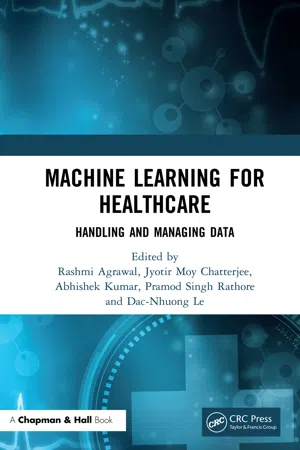
Machine Learning for Healthcare
Handling and Managing Data
Rashmi Agrawal, Jyotir Moy Chatterjee, Abhishek Kumar, Pramod Singh Rathore, Dac-Nhuong Le, Rashmi Agrawal, Jyotir Moy Chatterjee, Abhishek Kumar, Pramod Singh Rathore, Dac-Nhuong Le
- 212 páginas
- English
- ePUB (apto para móviles)
- Disponible en iOS y Android
Machine Learning for Healthcare
Handling and Managing Data
Rashmi Agrawal, Jyotir Moy Chatterjee, Abhishek Kumar, Pramod Singh Rathore, Dac-Nhuong Le, Rashmi Agrawal, Jyotir Moy Chatterjee, Abhishek Kumar, Pramod Singh Rathore, Dac-Nhuong Le
Información del libro
Machine Learning for Healthcare: Handling and Managing Data provides in-depth information about handling and managing healthcare data through machine learning methods. This book expresses the long-standing challenges in healthcare informatics and provides rational explanations of how to deal with them.
Machine Learning for Healthcare: Handling and Managing Data provides techniques on how to apply machine learning within your organization and evaluate the efficacy, suitability, and efficiency of machine learning applications. These are illustrated in a case study which examines how chronic disease is being redefined through patient-led data learning and the Internet of Things. This text offers a guided tour of machine learning algorithms, architecture design, and applications of learning in healthcare. Readers will discover the ethical implications of machine learning in healthcare and the future of machine learning in population and patient health optimization. This book can also help assist in the creation of a machine learning model, performance evaluation, and the operationalization of its outcomes within organizations. It may appeal to computer science/information technology professionals and researchers working in the area of machine learning, and is especially applicable to the healthcare sector.
The features of this book include:
- A unique and complete focus on applications of machine learning in the healthcare sector.
-
- An examination of how data analysis can be done using healthcare data and bioinformatics.
-
- An investigation of how healthcare companies can leverage the tapestry of big data to discover new business values.
-
- An exploration of the concepts of machine learning, along with recent research developments in healthcare sectors.
-
Preguntas frecuentes
Información
1
Fundamentals of Machine Learning
1.1 Introduction
1.2 Data in Machine Learning

Data, information and knowledge.

Types of data.
- 1) Volume: the main characteristic feature or dimension of big data is its sheer volume. The term volume refers to the amount of data an organization, or an individual, collects and/or generates. Currently, to qualify as big data, a minimum of 1 terabyte is the threshold for big data which stores as much data as would fit on 1,500 CDs or 220 DVDs, (or enough to store approximately 16 million Facebook images). The vast amounts of data are generated every second. E-commerce, social media, and various sensors produce high volumes of unstructured data in the form of various audio, images, and video files. Today big data is also generated by machines, networks, and human interaction on systems and the volume of data to be analyzed is massive.
- 2) Variety: is one of the most attractive dimensions in technology, as almost all information is digitized nowadays. Traditional data types or structured data include information (such as date, amount, and time) in a structured way which can easily fit neatly in a relational database. Structured data is augmented by unstructured data. Modern day data sources include Twitter feeds, YouTube videos, audio files, MRI images, web pages, web logs, and anything else that can be captured and stored and does not require any meta model for its structure to access it later on.
- Unstructured data i...
Índice
- Cover
- Half-Title
- Title
- Copyright
- Contents
- Preface
- Acknowledgments
- Editors
- List of Contributors
- 1. Fundamentals of Machine Learning
- 2. Medical Information Systems
- 3. The Role of Metaheuristic Algorithms in Healthcare
- 4. Decision Support System to Improve Patient Care
- 5. Effects of Cell Phone Usage on Human Health and Specifically on the Brain
- 6. Feature Extraction and Bio Signals
- 7. Comparison Analysis of Multidimensional Segmentation Using Medical Health-Care Information
- 8. Deep Convolutional Network Based Approach for Detection of Liver Cancer and Predictive Analytics on Cloud
- 9. Performance Analysis of Machine Learning Algorithm for Healthcare Tools with High Dimension Segmentation
- 10. Patient Report Analysis for Identification and Diagnosis of Disease
- 11. Statistical Analysis of the Pre- and Post-Surgery in the Healthcare Sector Using High Dimension Segmentation
- 12. Machine Learning in Diagnosis of Children with Disorders
- 13. Forecasting Dengue Incidence Rate in Tamil Nadu Using ARIMA Time Series Model
- Index